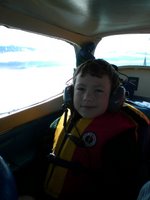
Thinking about a plane crash is no fun. In fact, it is really too horrible to imagine. But gravity remains a fact of life and Juneau is a town without a road. Getting out of town and staying on the Earth's surface means riding on the infrequent, middle of the night ferry system. We happen to have a pilot and a small plane in the family, so usually we fly.
The calamities that can kill you in a plane crash around here are trauma, fire, drowning, hypothermia and exposure. Gawd, that is a horrible list. I really don't think too much about the risk, though, rather like getting in a car and hurling down a freeway surrounded by huge trucks going 70 mph. But we do prepare.
Seatbelts are standard, of course. We all have headsets to protect our ears from the noise and also to communicate with each other. Dave or I could remind each other or the kids what to do if a rough landing was expected. Choosing the best place to land would help reduce the trauma of a crash quite a bit. Bracing and padding might help, too. We would try to surround the kids with jackets or duffle bags if we had time. A mid-air collision killed a bunch of people up north earlier this year. Prevention would be the only strategy there. Good pilots report their position frequently so everybody in the area should know where other planes are.
Getting out of the plane is the next immediate step. Surviving the trauma of a bad landing puts you in a wrecked plane in icy cold water or on a mountain side or rocky beach. Wrecked planes on wheels sink like a stone. Seatbelts need to stay on until after impact but then need to come off instantly. Doors or windows need to be opened and people need to get out of the plane. Back seat passengers may need help. We all wear life jackets all the time. Some are inflatable so once out of the plane, we would need to pull the cords to inflate the life jackets. Hopefully, everyone is uninjured and out of the plane quickly, before it sinks. We would always try to land near a beach but who knows? The next step is getting rescued before the cold water kills you.
Crashing on land with wings full of fuel means a fire is possible. Again, the strategy is to quickly get out of the plane and get away. Clothing strategies for fire and cold water exposure are actually opposites so we tend toward the middle ground. In the water, cotton and natural fibers are dumb as they do nothing to keep you warm when you get out, but in a fire, synthetics melt on your skin and greatly increase the injury. We usually wear jeans and fleece jackets.
To initiate a rescue, the first step would be announcing that there are people in trouble. The plane is equipped with a radio and GPS, so an SOS could be called with a situation and position report before landing. If we were in the water, we could signal searching planes with mirrors, dye packets or strobe lights that we have in our pockets whenever we are in the plane. On land, it would be easier to be found and less urgent. We could make a fire or some sort of signal on a beach. We always file a flight plan so the FAA knows when we take off, where we are going and when we expect to land. If Dave didn't call in to close the flight plan, a search would be launched.

The most important risk reduction strategies, however, are taking good care of the plane and choosing when to fly. Dave checks the plane carefully before each flight and has it looked over by a mechanic every year or whenever there is some hint of a problem. Once he discovered a bird's nest under the "hood". If a porcupine has chewed on one of the tires, taking off or landing isn't going to go smoothly. The engine has to keep turning the prop and the wings have to stay on. Everything has to work well on the plane.
The weather is a huge factor. We never really have to get in the plane and go. We can always wait for better weather. If we are expected back at work or for some reason, we have to be somewhere, well, actually we don't. It is better to miss work even if you can't call in then to fly into a cloud. Finding out what the weather is like is getting better every year. We can look on the Internet at webcams that show real time conditions and pilot reports are posted on the FAA's website. We always have enough fuel so if it looks good to go and then it isn't good enough, we can turn around and go back to our starting point. We have done just that more than once and we will do it again. Dave is due to fly home today, but the weather is bad and he can't call me from the cabin. I'll just wait. He can always come home tomorrow.
1 comment:
I've come to believe that it's best to just use as much common sense as you can, and get on with things. You obviously take very sensible precautions.
Thank you for the "porcupine eating the tires" aside, though -- it made me laugh in an otherwise rather somber moment.
Post a Comment